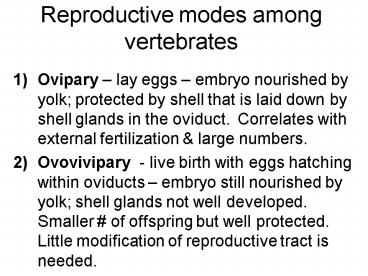Reproductive modes among vertebrates - PowerPoint PPT Presentation
1 / 21
Title:
Reproductive modes among vertebrates
Description:
fusiform (teardrop or torpedo) body shape (i pressure drag) ... body stiff retains teardrop shape even during undulation (i all forms of drag) ... – PowerPoint PPT presentation
Number of Views:101
Avg rating:3.0/5.0
Title: Reproductive modes among vertebrates
1
Reproductive modes among vertebrates
- Ovipary lay eggs embryo nourished by yolk
protected by shell that is laid down by shell
glands in the oviduct. Correlates with external
fertilization large numbers. - Ovovivipary - live birth with eggs hatching
within oviducts embryo still nourished by yolk
shell glands not well developed. Smaller of
offspring but well protected. Little
modification of reproductive tract is needed.
2
Reproductive modes (cont.)
- 3) Vivipary live birth embryo nourished early
by yolk most development nourished by mother - uterine milk nutrient-rich secretion from
special projections of the oviduct lining - unfertilized eggs mother continues to ovulate
and fetuses eat the excess eggs - placental nutrients pass from moms blood into
fetus via special vascular membrane placenta
derived from yolk sac in most non-mammals (more
later!)
3
frog
turtle
Ovipary
salmon
robin
giant skate
4
- Freshwater fishes
- Skin impermeable
- Problem gills must
- remain permeable
- 3) Passive loss of salts and
- uptake of H2O
- How do we regulate to main-
- tain homeostasis?
- 4) Salt actively transported
- in by cells in gills
- 5) Water excreted in dilute
- urine huge kidneys
passive
active
- Marine fishes
- Skin impermeable
- Gills permeable
- Passive uptake of
- salt and loss of H2O
- How do we maintain
- homeostasis?
- 4) Chloride cells in gills
- actively spit out salts
- 5) Drink lots of water
- tiny kidneys with low
- urine output
passive
active
5
Distal convoluted tubule
Proximal convoluted tubule
Bowmans capsule
Glomerulus
Collecting duct
Loop of Henle
6
(No Transcript)
7
ammonotelic
ureotelic
uricotelic
8
(No Transcript)
9
(No Transcript)
10
Air bladders
- Epi- and mesopelagic fishes have large air
bladders to regulate buoyancy - Problem as you descend, pressure h causes air
to compress in bladder as you ascend, pressure i
causes bladder volume to h - To maintain neutral buoyancy, you have to
maintain constant volume - So you have to h air secretion into bladder while
descending and remove air from bladder while
ascending - How is this regulated?
11
oval bladder is highly permeable O2 passes
easily from bladder into blood
most of air bladder is impermeable to O2 except
in region of red gland
Sphincter controls O2 emitted into oval bladder
as fish goes up and air bladder volume expands,
sphincter opens to allow O2 to enter oval
bladder and be absorbed into blood stream
counter-current mechanism allows high O2 to
build up in red gland so as O2 in bladder h
with h pressure, free O2 also h this allows
bladder to keep filling as fish goes down
12
luciferase Ca2
luciferin ATP O2 ? oxyluciferin AMP light
13
(No Transcript)
14
Water holds only about 1 dissolved oxygen. How
do fishes maximize the amount of O2 that they
can extract from the water? Counter-current
flow in the gills!
15
(No Transcript)
16
Pitch is controlled by caudal fin and paired
fins Roll is controlled by median fins (caudal,
dorsal anal) Yaw is controlled by median fins
plus large stiff head
17
angle of attack
18
- How to minimize drag?
- fusiform (teardrop or torpedo) body shape (i
pressure drag) - streamlining smooth bodygtsmall scales, fins
fit into - grooves in skin (i frictional drag)
- body stiff retains teardrop shape even during
undulation (i all forms of drag) - high aspect ratio of caudal fin (i vortex drag)
19
Aspect ratio fin height mean
chord
high aspect ratio
low aspect ratio
20
Most fish develop thrust using their caudal fins
but there are other ways!
Modified carangiform
Carangiform
Labriform pectoral fins
Balistiform dorsal anal fins
21
Ostraciform caudal fin only
Anguilliform long skinny body
Plus all kinds of unique mechanisms!
Flying fish!
Seahorse uses dorsal fin only































